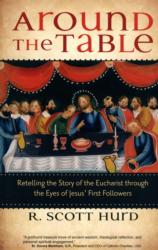
“Around the Table: Retelling the Story of the Eucharist Through the Eyes of Jesus’ First Followers”
by R. Scott Hurd.
Ave Maria Press (Notre Dame, Indiana, 2017).
160 pp., $14.95.
“Around the Table” is what one might call a devotional book that gives you more than prayers and discussion questions.
Each of the 14 chapters focuses on a scriptural personage, some of whom the reader may not expect — including Mary, the mother of Jesus; St. Paul, formerly Saul of Tarsus; St. Cleopas from the road to Emmaus narrative in Luke’s Gospel; St. Peter; St. Mary Magdalene; and St. Longinus, whom legend — Hurd says “tradition” — identifies as the Roman soldier who thrust a spear into Jesus’ side as he hung on the cross.
Hurd, senior director for leadership formation with Catholic Charities USA, provides for each saint a biographical essay, questions for journaling, contemplation or discussion, Scripture citations for reference or further study and a closing prayer.
[hotblock]
Each of this book’s essays is an exercise in imagination, since the author invites the reader to put himself or herself in the shoes of the saint chosen to inspire the essay at hand. Hurd writes that “St. Ignatius of Loyola, the 16th-century founder of the Jesuits, gave me license to use my imagination this way.”
For example, after his short biographical essay on the apostle St. Matthew, Hurd begins: “Few people in your hometown of Capernaum will actually look you in the eye, let alone have a conversation with you. You are a tax collector, and aside from your fellow tax collectors and a handful of equally wealthy friends, you are essentially an outcast.”
As each essay progresses, in effect Hurd asks the reader-as-biblical-personage to imagine what his or her experience of the Eucharist was like in the years following the death and resurrection of Jesus. To quote again from the essay on St. Matthew: “As the years pass after Jesus returns to his Father, you will celebrate the Lord’s Supper with other followers of Jesus as you fellowship expands — first with other Jews, and later, far to the south in Ethiopia, where you will journey to spread the good news of Jesus’ forgiveness — and where you will end your days.”
This book may appeal more to the right-brain-dominant than to the left-brain-dominant, as it asks readers to enter into a kind of willing suspension of disbelief and to imagine what it was like to be a Christian during the first decades of the church’s history. Presuming the reader is, indeed, willing and able to do this, then “Around the Table” may become a much appreciated resource for prayer and spiritual enrichment.
***
Finley is the author of more than 30 books on Catholic themes, including “The Rosary Handbook: A Guide for Newcomers, Old-Timers and Those In Between” (Word Among Us Press) and “What Faith is Not “(Sheed & Ward).
PREVIOUS: ‘The Fate of the Furious’ pushes loyalty to the red line
NEXT: Film students travel to ‘Endor’ to shoot ‘Star Wars’ fan film



Share this story